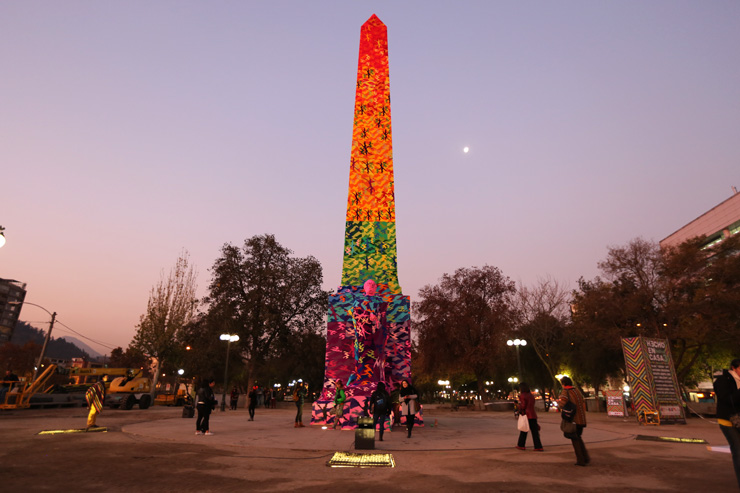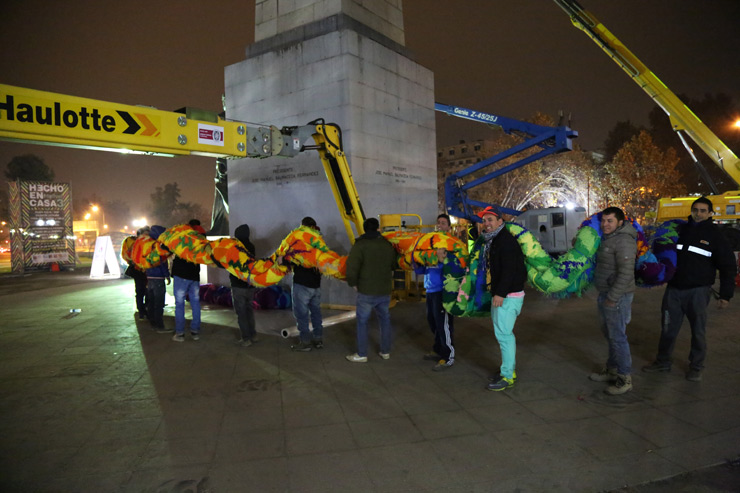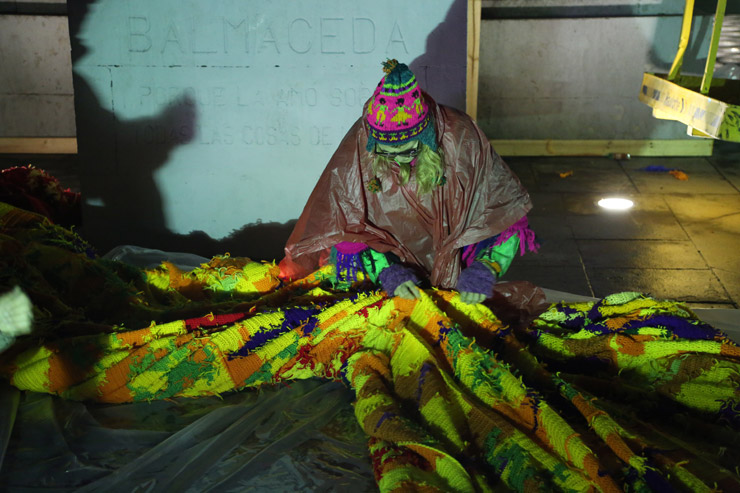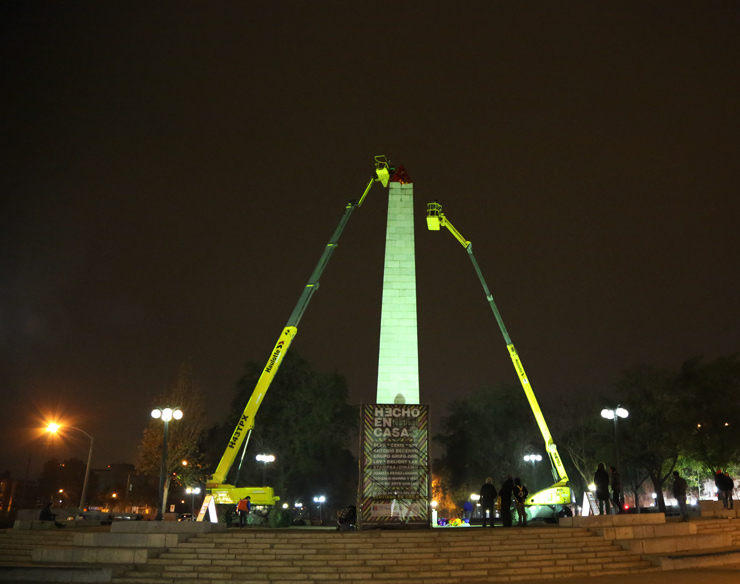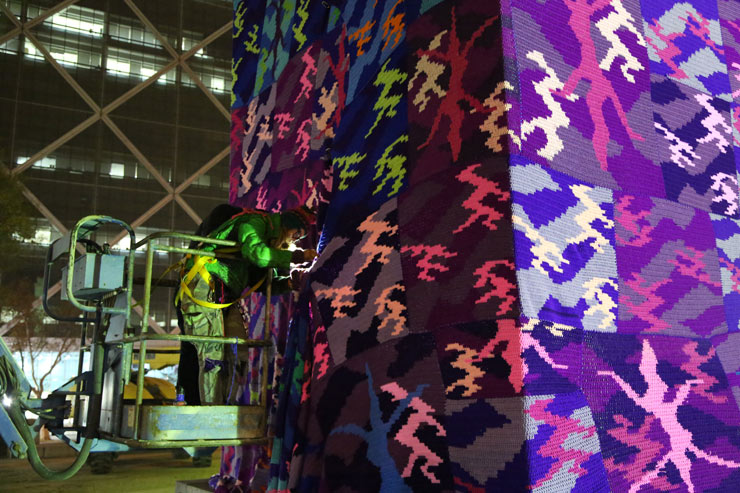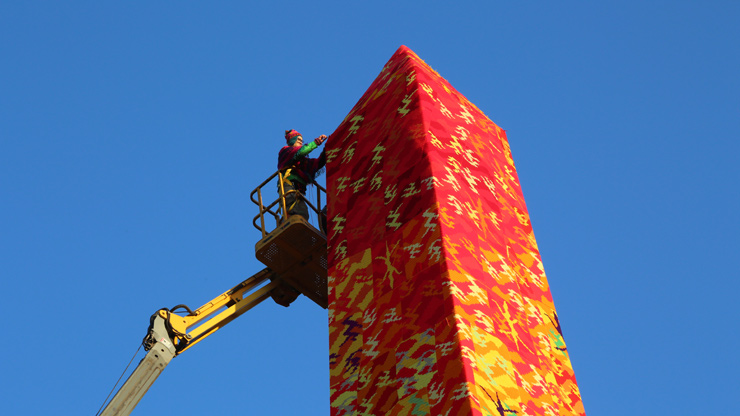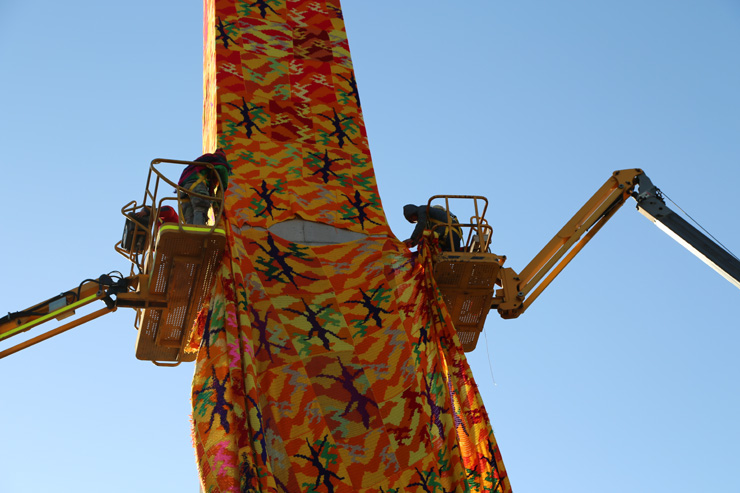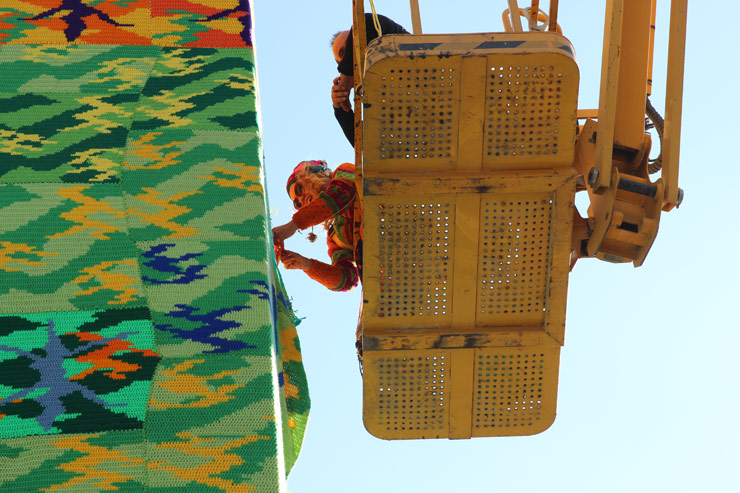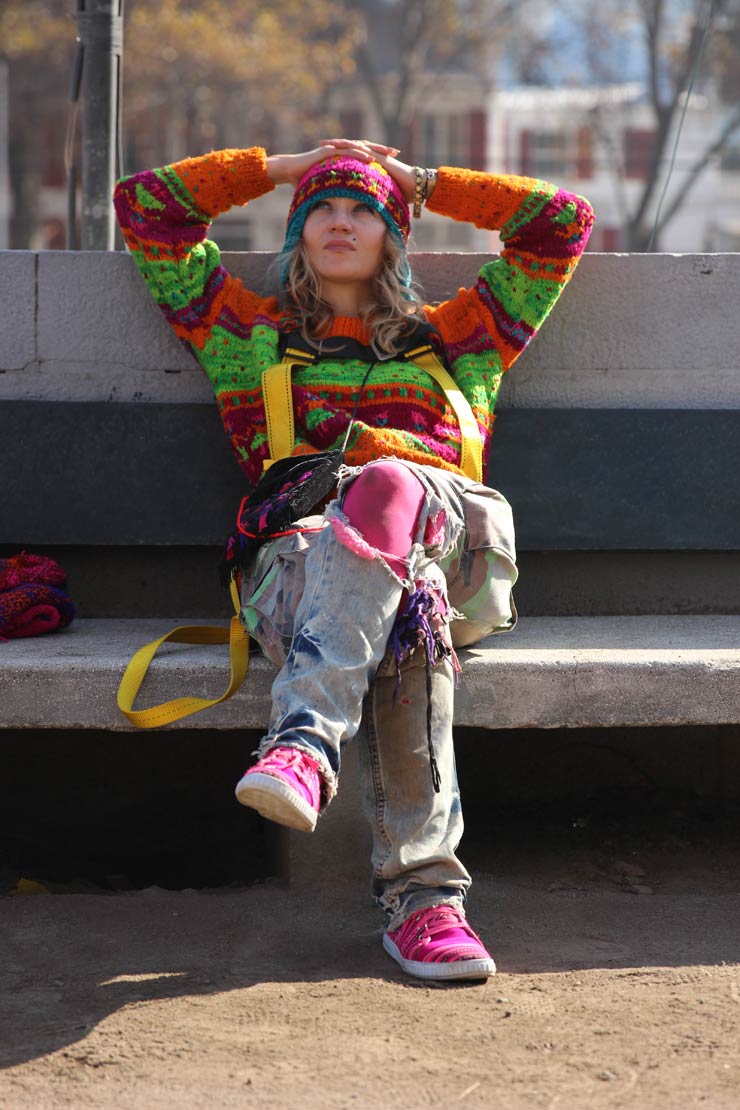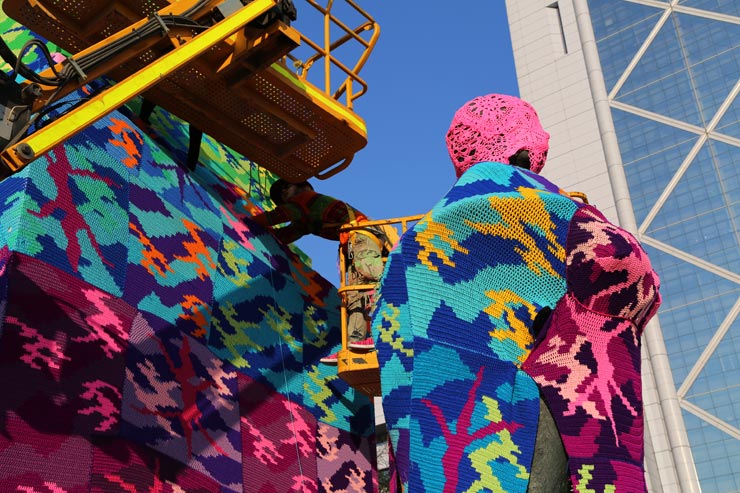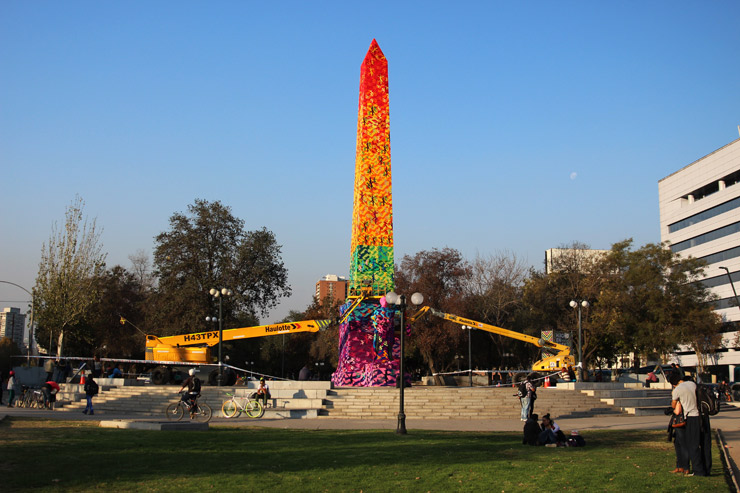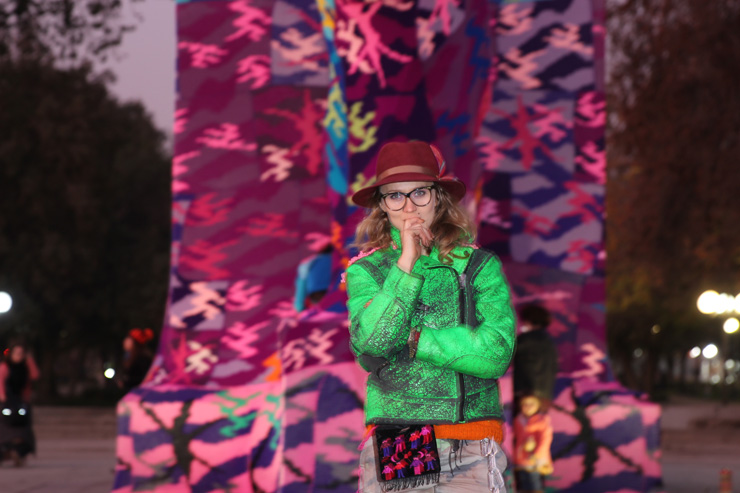“I surprised myself with the patience I had,” Olek tells us about the arduous bureaucratic game of waiting and preparing that she and her team played to get this big phallus up in Santiago de Chile for Hecho En Casa . The Street Artist has taken on ever-larger structures, sculptures, and monuments to transform with crocheted camouflage over the last decade and she specifically chose this one she says because of its shape.
Olek. “Primavera” Santiago, Chile. May, 2015. (photo © Curro Guerrero)
“I decided to support and draw attention to gay rights by crocheting the obelisk in Santiago de Chile, a gigantic phallic object, covered in my signature rainbow crochet, meant to encourage dialog about human rights and convey the sense of urgency that I feel is needed to help gay people to not feel persecuted.” It’s unclear how much of this storyline the Chilean hosts knew in advance but the skyward pointing obelisk and rainbow sheath was approved before Olek boarded the plane in New York. She learned that permission had been rescinded when she arrived.
Days of drama followed.
Days of drama followed.
Olek delivers a Polish folk axiom: “nie mow ‘hop’ zanim nie przeskoczysz,” which loosely translates as “Don’t count your chickens before they hatch” and that is how she describes the continuous uncertainty she felt concealing the bad news from her small group of assistants who were feverishly preparing for a project. “I was truly sad and devastated but I didn’t want to share the news and my emotions with my crochet team,” about this project.
Olek. “Primavera” Santiago, Chile. May, 2015. (photo © Curro Guerrero)
“Hecho En Casa is an event created by a group of independent artists,” says organizer Felipe Zegers, and because the artists have gained support of government and business to promote cultural tourism, they usually can be persuasive with their track record of more than 50 successful artist installations throughout the city.
It is unclear what exactly stalled the permission for this project that Olek had first conceived of in 2012, but it didn’t help that their trip had begun with a strike by customs workers that held her mountain of crocheted material and yarn hostage.
Olek. “Primavera” Santiago, Chile. May, 2015. (photo © Curro Guerrero)
“When the materials for Olek were arriving the Chilean Aduna (border) patrol had entered into an indefinite strike and it delayed our project,” says Zegers. “This lead to last minute problems where we had to once again get many people to agree on logistics and dates and to re-coordinate everything days before installation was to begin.”
Four days of cold weather and working on a cold cement floor, and some of Olek’s folks started to feel ill but production continued – as did behind the scenes negotiations. “I kept visualizing how to install this monster piece,” she says with customary gusto – and freely admits she was nervous about whether she could pull it off.
Olek. “Primavera” Santiago, Chile. May, 2015. (photo © Curro Guerrero)
But she says she kept herself thinking positively, “I knew that when I was ready, the permission would come.” Yet, days passed with foggy answers about whether her piece would be re-approved for installation. Some talk about doing it guerrilla-style even began.
Suitably diplomatic, Mr. Zegers describes the even-handed appeal he uses in smoothing communications. “The best course of action is to try not to step over anyone. As always we take everyone’s position involved into consideration when trying to resolve any issues.”
“Olek also helped by handing over a bottle of Polish Vodka.”
Of course she did!
Olek. “Primavera” Santiago, Chile. May, 2015. (photo © Curro Guerrero)
And by ‘hand over’ he means ‘hand over to the mayor in public while cameras were rolling.’
We weren’t surprised to learn that the enterprising dynamo positioned herself along the route of a publicized tour that the Mayor Claudio Orrego was taking. Mr. Orrego was reviewing some of the first installed artworks of the festival and then suddenly there appeared the colorful artist with a bottle of Polish vodka to present to him. It was no plain gift, says Zegers, “It was crocheted of course, and she gave it over to the mayor in a gesture that was well received by everyone – including the press.”
“We traded stories and we laughed,” Olek says, adding, “The press also took pictures.”
Olek. “Primavera” Santiago, Chile. May, 2015. (photo © Curro Guerrero)
Within a relatively short time the installation was re-approved. “We moved quickly, as the whole project had begun to crumble, and we regained the full cooperation of the National Monuments Council, who unlocked the permits and gave us a letter of support for the project.”
Olek and the team happily agreed to begin it at night. Yes, at night. “We learned that we could do it after midnight,” she says, “as we had to wait until a student strike was over that started in Plaza Italia where the obelisk stands.”
Olek. “Primavera” Santiago, Chile. May, 2015. (photo © Francesco Garcia)
Eventually installation began at 1:30 in the morning and continued past dawn. “I really had an amazing team,” she says. “We all worked really hard and every person added to the success of this installation.”
“At dawn it was amazing to see the city sky so clean and sunny,” says Mr. Zegers, “the colors shone brightly and, while it was still cold, the monument looked cozy and warm. Many people got off the bus to admire it and people started to come at all hours to see the project.
Olek. “Primavera” Santiago, Chile. May, 2015. (photo © Francesco Garcia)
Lost in the drama may have been the original message Olek had about LGBT rights in society, but the artist prefers to say that it took on an additional meaning for her as a story of perseverance. “With every piece I create I try to bring awareness to various issues around the world, issues that are important to me,” she says. “It’s disturbing that we still have to fight for fundamental human rights today, specifically women’s and gay rights.”
In her reading of works by the Chilean poet Pablo Neruda she took additional inspiration and now thinks of these words when she reflects on the arduous nature of that project and the long path for equality that LGBT people continue to walk along worldwide.
“Podrán cortar todas las flores pero nunca detendrán la primavera.” (They can cut all the flowers, but they never stop the spring.) – Pablo Neruda
Olek. “Primavera” Santiago, Chile. May, 2015. (photo © Curro Guerrero)
Olek. “Primavera” Santiago, Chile. May, 2015. (photo © Francesco Garcia)
Olek. “Primavera” Santiago, Chile. May, 2015. (photo © Francesco Garcia)
Olek. “Primavera” Santiago, Chile. May, 2015. (photo © Nico Rojas)
<<>>><><<>BSA<<>>><<<>><><BSA<<>>><><<>BSA<<>>><<<>><><BSA
Please note: All content including images and text are © BrooklynStreetArt.com, unless otherwise noted. We like sharing BSA content for non-commercial purposes as long as you credit the photographer(s) and BSA, include a link to the original article URL and do not remove the photographer’s name from the .jpg file. Otherwise, please refrain from re-posting. Thanks!
<<>>><><<>BSA<<>>><<<>><><BSA<<>>><><<>BSA<<>>><<<>><><BSA
Other Articles You May Like from BSA:
Welcome to BSA Images of the Week, where that silence you hear is the controlled collapse of the entire economy. Blink. Notwithstanding the drama that monopolizes the airwaves courtesy our daily...
In San Francisco for his solo gallery show that is running until December 7, the Street Artist/graffiti artist/fine artist named Word To Mother had some time to hit a truck or two and a roll down gate...
Our weekly focus on the moving image and art in the streets. And other oddities. Now screening : 1. VHILS Splash and Burn 2. MONUMENTA PREPARES with The Intelligence of Many SEPT 2018 a. Yaira...
“The only way to support a revolution is to make your own.” Abbie Hoffman EKG Labs. Wastedland 2. Detroit, September 2016. (photo © Jaime Rojo) PREAMBLE At any given moment a coun...
It's not all going to the dogs, peeps - it just looks like it sometimes. We start this week with a ferocious one from Zimer, and follow it by a chihuahua that it could probably e...
 BROOKLYN STREET ART LOVES YOU MORE EVERY DAY
BROOKLYN STREET ART LOVES YOU MORE EVERY DAY